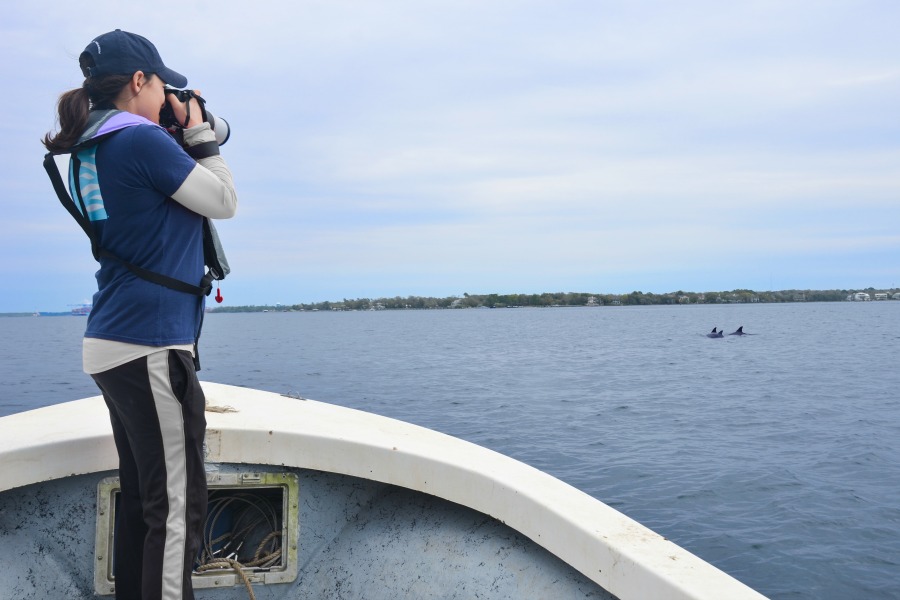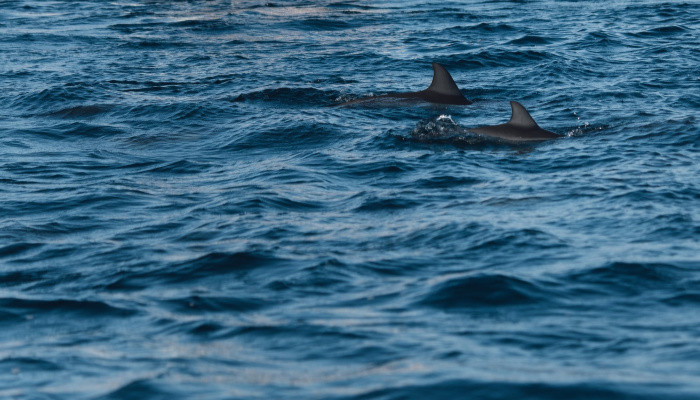Social distancing is our new normal for the foreseeable future, but for the local dolphin population, it’s a practice we should always have in place! Since today is National Dolphin Day, we wanted to take some time virtually connecting with Meghan, our resident dolphin expert at the Aquarium, and learn how we can respect these charismatic creatures living off the coast of Charleston!

Tell us about your history working with dolphins.
I have worked with Atlantic bottlenose dolphins in a managed care setting doing training, husbandry, and research. I have also studied wild Atlantic spotted dolphins in the Bahamas, and currently study wild Atlantic bottlenose dolphins here in Charleston. Currently, I work on a team with Dr. Pat Fair, our scientist in residence at the South Carolina Aquarium. Our team includes scientists from USC at Beaufort, MUSC, and the University of Aberdeen in Scotland. Together, we are studying how physical and acoustic changes in the dolphins’ environments affect their lives.
What type of dolphins do we have off the coast of South Carolina?
The most common species of dolphins we see off the coast here in South Carolina is the Atlantic bottlenose dolphin (Tursiops truncatus). These are most prevalent inshore, but you might also see Eastern spinner dolphins (Stenella longirostris) and Atlantic spotted dolphins offshore (Stenella frontalis). There are many other species of whales and dolphins that can be found off our coast, but these are the most common and most familiar! Studies on bottlenose dolphins in our area have found that depending on the time of year, we might have between 300 and 900 bottlenose dolphins off our coast.
What threats do dolphins face?
Dolphins face natural threats such as predation (sharks) and disease. However, the greatest threats to dolphins are from humans. Dolphins are often found entangled in abandoned fishing gear, struck by boat propellers and carrying large contaminant loads in their blubber from human pollutants. Climate change and plastic pollution also pose a threat to dolphins and their environment.
Can you tell us something surprising about dolphins, or a favorite fun fact?
People often think that dolphins are smiling and are naturally “friendly”. The truth is, dolphins can’t change their facial expressions at all like humans can! They are actually large, powerful predators with 80-100 sharp teeth. Another fun fact – dolphins sleep with one half of their brain at a time!
How can I help dolphins?
If you love dolphins and want to help them, the best thing you can do is be dolphin S.M.A.R.T.
S – Stay back 50 yards from dolphins.
M – Move away cautiously if dolphins show signs of disturbance.
A – Always put your engine in neutral when dolphins are near.
R – Refrain from feeding, touching, or swimming with wild dolphins.
T – Teach others to be dolphin SMART!!
What do I do if I see a stranded dolphin (or other marine animal)?
If you see a stranded dolphin, the best thing to do is call the South Carolina Department of Natural Resources Wildlife Stranding hotline at 1(800) 922-5431. Do not attempt to touch the animal or push it back in the water! The animal is likely very sick and very stressed. You are not helping it by pushing it back into the water. In fact, you could cause it more harm in doing so. It could also be carrying a disease that could make you sick, too. Call the hotline, and follow the instructions given to you by the wildlife experts.
If we could have one takeaway about dolphins, what would it be?
I think the most important thing I want you all to remember is that dolphins are wild animals. They have a reputation for being friendly, but it can be very dangerous to approach wild dolphins; it’s dangerous for us and dangerous for the dolphins, too! Dolphins are large powerful predators that can be aggressive if they feel threatened, like if they are approached by humans in their habitat. You can harm a dolphin by getting too close to them in your boat, and especially by feeding dolphins. Dolphins fed by people begin to associate people with food, and that means they spend less time looking for food themselves and doing other natural behaviors. Finally, it’s illegal to approach wild marine mammals within 50 yards. Failure to respect this law can result in hefty fines! If you love dolphins and want to protect them, the best thing you can do is admire them from a distance, and teach others to do the same!


